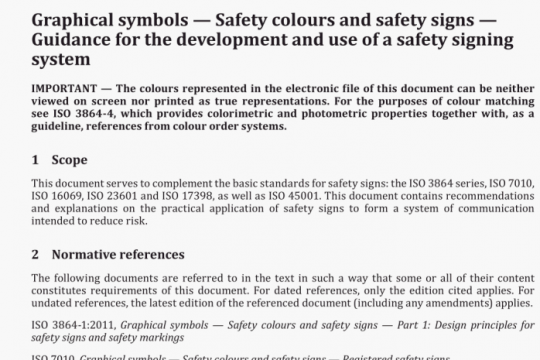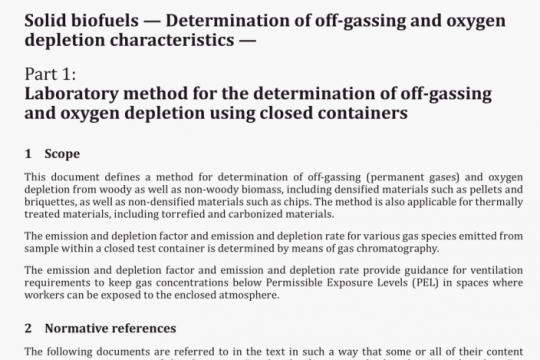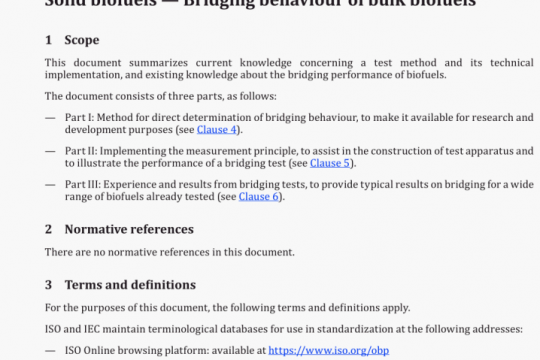ISO 334 pdf free download
ISO 334-2020 pdf free download.Coal and coke – Determination of total sulfur – Eschka method.
8.1.2 For coke
Take a test portion oil g, weighing to the nearest 0,1 mg.
8.2 Charging the crucible
Cover the bottom of the crucible (6A) uniformly with 0,5 g of the Eschka mixture (5.1) weighed to the nearest 0.1 mg. Mix the test portion intimately with 2,5 g of the Eschka mixture, weighed to the nearest 0,1 mg, in a suitable vessel. Transfer the mixture to the 25 ml crucible. Level the contents by tapping the crucible gently on the bench and cover the contents uniformly with 1,0 g of the Eschka mixture, weighed to the nearest 0,1 mg.
The entire 4 g of the Eschka mixture should be weighed out and the 0,5 g and 1 g portions, required for the bottom and top layers, should be extracted from this. For this purpose, it is convenient to calibrate a small glass tube for each bath of the Eschka mixture to deliver 0,5 g and I g without weighing. The bottom layer of the Eschka mixture below the test portion mixture reduces attack on the porcelain surface so that the extraction of sulfate with hot water is complete even when the surface deteriorates.
8.3 Ignition
8.3.1 For coal
Place the charged crucible (and any others up to the limit ot the muttle turnace capacityJ in the cold muffle furnace (3) and raise the temperature to 800 °C ± 25 °C in about 1 h, maintaining this temperature [or at least a further 1,5 h. Withdraw the crucible (or crucibles) and allow to cool.
NOTE The cracking of porcelain crucibles can be prevented if they are slowly cooled by insertion in supports of light porous firebrick on removal from the muffle furnace.
8.3.2 For coke
Place the charged crucible (or crucibles) on the cold insulating flat plate () and insert into the muffle furnace (f3) at a temperature of 800 °C ± 25 °C, maintaining this temperature for at least a further 1,5 h. Withdraw the crucible (or crucibles) and allow to cool. See Note In 83..1.
8.4 Recovering the residue
Transfer the ignited mixture from the crucible to a 400 ml beaker containing 25 ml to 30 ml of water. If unburnt particles are present, the determination shall be stopped and the test repeated. Wash the crucible thoroughly with about 50 ml of hot water and add the washings to the contents of the beaker.
8.5 Extraction
Place a watch glass on the beaker and then, while tilting the watch glass, carefully add enough hydrochloric acid (&Z) to dissolve the solid matter (17 ml will normally be required), warming the contents of the beaker to effect solution. Boil for 5 mm to expel carbon dioxide and filter, collecting the filtrate in a 400 ml conical beaker.
NOTE A medium-textured, doubly acid-washed filter paper or a filter-paper pad is recommended for speed of filtration.
To prepare the filter-paper pad, shake doubly acid-washed filter-paper clippings, in pieces with areas of approximately 1 cm2, with water in a bottle until the paper is thoroughly disintegrated. Place a porcelain filter cone of 25 mm in a 75 mm funnel, close the stern of the funnel with a finger, and add water until the cone is immersed and the funnel stem is lull. Shake, onto the cone, sufficient paper pulp to form a pad 5 mm thick, and level it with a flat-ended glass rod. Allow the excess water to drain away by removing the finger from the stem and as drainage ceases, lightly tamp the pad around the edges with the glass rod. A final wash with water renders the filter ready for use.
Wash the filter with five 20 ml portions of hot water.
Add two or three drops of the methyl red indicator solution (5.5) to the combined filtrate and washings, and then cautiously add the ammonia solution (5.6) until the colour of the indicator changes and a trace of precipitate is formed. Add enough hydrochloric acid (5.2) to just redissolve the precipitate and then add 1 ml in excess.
8.6 Precipitation of barium sulfate
Alter extraction, dilute the solution, if necessary, to approximately 200 ml and cover the beaker containing the solution with a watch glass. Heat the covered beaker until the solution boils and then reduce the heating slightly until ebullition of the solution ceases. Then add 10 ml of the cold barium chloride solution (SA) from a pipette with a delivery time of approximately 20 s so that the barium chloride solution falls into the centre of the hot solution while it is being agitated. Keep the solution just below boiling point for 30 mm.ISO 334 pdf download.




